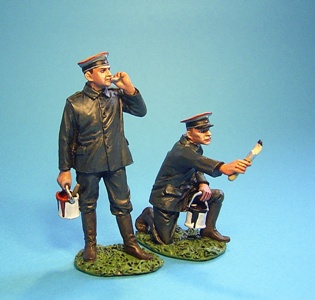 >
>
KNIGHTS OF THE SKIES
GERMAN GROUNDCREW AND ACCESSORIES
GGC-05
German Ground crew, Painters
(2pcs)
US$62
ACE-07, ACE-07P, GGC-03, GGC-05 & GGC-07
During WW1 Germany changed the "style" of
the Iron Cross no less than 5 times.
In the short lifespan of planes and pilots
it becomes a very usefull tool in identifying when photographs were taken.
At mobilization on 1 August 1914, Idflieg instructed the Feld Flieger Abteilungen,
(Field Flying Detachments) to paint a black straight sided cross
at the mid-point of the wing panels on both sides of the wings and on both sides of the rudder.
The Idflieg (Inspektion der Fliegertruppen - "
Inspectorate of Flying Troops")
was the bureau of the German Empire that oversaw German military
aviation prior to and during World War I.
A telegram was sent to the aircraft manufacturers,
instructing them to paint curve style Iron Crosses
in the appropriate places on the wings and rudder.
The serial number was to be moved to the fin or fuselage sides. The Idflieg directive,
was without specific dimensions or form,
each factory came up with their own curve style cross form.
At this time all military vehicles,
including aircraft were painted Field Grey
. Because of the lack of contrast,
between the Field Grey wings and rudder, and the black cross, the Idflieg ordered,
sometime in September or October 1914,
that a square white field be painted surrounding
the black crosses on both sides of the wing panels and rudder.
On 25 July 1916,
the Idflieg sent out a directive that dimensionally specified the standard cross form.
The standard Iron Cross was to be painted on a square white cross field,
painted on the top surface of the upper wing, near the wing tips;
the bottom surface of the lower wing, near the wing tips;
on both sides of the fuselage and rudder.
The Idflieg sent out a directive dated 29 October 1916,
instructing Field units and the manufacterers
to paint out the white cross fields
and leave only 5cm white border surrounding the black Iron Cross.
There was some concern that the white cross fields
were being mistaken for allied cockades.
On 20 March 1918,
the Idfleig sent out telegram Order 41390 which directed that
all aircraft crosses would be the straight cross with a 15 cm white border surrounding black cross.
This was the introduction of the Balken (beam) style cross.
The proportions of the cross was not given.
But, this was corrected by a second set of instructions after several calls and telegrams.
The directive stated the rudder was to be painted white
with the black beam cross painted on the white rudder.
These changes in the crosses were to be carried out no later than 15 April 1918.
The cross form made by the Jasta personnel
in the field varied all over the place.
Most just drew straight lines fom the tips
of the arms resulting in very fat crosses with a ratio of 1:2.5 and some 1:3.
The next change which occured on 13 May 1918,
was to the Latin Cross with the height to width ratio of 5:4.
This cross was a complete new cross with the vertical bar of the cross to be full chord,
from leading edge to trailing edge.
The length of the horizontal bar was to be 4:5 of the vertical bar.
The width of the bar was to be 1:8,
and the white border will form right angles between the cross arms,
the white border would not enclosed the ends of the cross arms.
The width of white border to the bar width will be 1:4, i.e. the vertical height were 1000 mm,
the horizontal bar would be 800 mm
the bar width would be 125 mm and the white border would 31.25 mm wide.
The final change in the German national markings
was on 25 June 1918 when a directive was sent by
telegram to all units and manufacturers to change the height to wide ratio from 5:4 to 1:1,
the lengths of the vertical and horizontal bars were to be equal lengths.
For example the upper wing cross on a Fokker D.VII
would be changed from 1600 x 1280 to 1600 x1600 mm,
the bar would be 200 mm wide and the white border 50 mm wide.
There were no further changes
to the German national markings to the end of the war.

We now accept PAYPAL,
to purchase your figures please send your order by e-mail to
inquiry@johnjenkinsdesigns.com
after checking that everything is available,
you will be billed via PAYPAL.
your order will be shipped on confirmation of payment.
worldwide airmail 12%
(minimum postage us$10)
JOHN JENKINS DESIGNS
UNIT 6H, TOWER 1,
KING LEY IND. BUILDING,
33-35 YIP KAN STREET,
WONG CHUCK HANG,
HONG KONG,
tel/fax; 852 2553 9313
